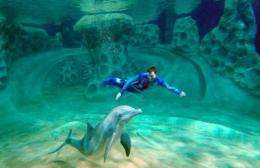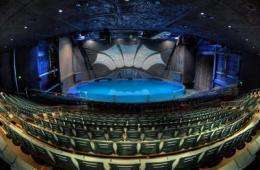Systems engineers help improve flow of visitors in Georgia Aquarium's new dolphin exhibit

More than 1,800 visitors can move smoothly through the Georgia Aquarium's new AT&T Dolphin Tales exhibit, entering and leaving through the same set of doors. Their experience is not by accident though -- before the exhibit opened, logistics experts at the Georgia Institute of Technology carefully studied how guests would move and recommended ways to improve their experiences while minimizing congestion.
"We offered Georgia Aquarium leaders accurate predictions on how the new AT&T Dolphin Tales exhibit would impact guest flow within the aquarium and how to optimize the operations logistics, efficiency and show schedules for the new exhibit," said Eva K. Lee, a professor in the H. Milton Stewart School of Industrial and Systems Engineering at Georgia Tech.
The new 84,000-square-foot AT&T Dolphin Tales attraction, which opened in April 2011, includes a theater with performances of Atlantic Bottlenose dolphins in a Broadway-style production with live actors and trainers, all set to an orchestral soundtrack. The exhibit also features a lobby area where visitors can be face-to-face with the dolphins through a 25-foot viewing window.
"We knew that managing the flow of guests through the new AT&T Dolphin Tales exhibit was going to be more difficult than the other aquarium galleries because guests would be entering and exiting the exhibit through the same space," said Brian Davis, director of education and guest programs at the Georgia Aquarium. "The logistical predictions and recommendations Georgia Tech provided us were extremely accurate and enabled us to ensure an amazing guest experience while remaining fiscally responsible."
To provide recommendations to the Georgia Aquarium on how to optimize visitor flow through the new exhibit, Lee and Georgia Tech graduate student Chien-Hung Chen created RealOpt-ABM, a large-scale modeling and decision support software suite that could model guest movement through the entire aquarium.
With this software, the researchers predicted guest flow through the new exhibit and the impact of the new exhibit to surrounding areas and overall visitor flow. They were also able to determine the best strategies for show scheduling, resource allocation, space usage, and theater loading and unloading. RealOpt-ABM produced recommendations that were implemented for operations design of the new exhibit, according to Joe Handy, vice president of guest experience at the Georgia Aquarium.

According to Lee, the software's success lies in its integrated simulation and optimization approach and its inclusion of human cognitive and behavioral elements. The software's computational speed also allowed for rapid solution strategies and on-the-fly reconfigurations. Facility layout, physical design and activities at specific points of interest were captured in sub-models, which were aggregated and coupled to form the overall model.
"RealOpt-ABM incorporated advances in agent-based simulation that capture the stochastic nature of the events within the aquarium, optimization of resource allocation and show schedules, and modeling of human cognitive decisions that affect show preference and guest behavior," explained Lee.
To validate the model, Lee, research engineer Niquelle Brown and 10 Georgia Tech students analyzed guest flow and behavior patterns in the entire aquarium before the new exhibit opened. Through time-motion studies in 2010, they collected guest flow data and captured the decisions guests made, such as turning left or right when they arrived at an intersection and how long guests spent in each exhibit area. The data showed that guest movement changed based on the time of day and what time guests arrived at the museum.
Using RealOpt-ABM, the researchers accurately predicted the amount of time required to load and unload the AT&T Dolphin Tales theater, depending on the number of guests, which led to a recommendation that performances be separated by at least 90 minutes to minimize congestion. The researchers also recommended that on days with fewer than 6,000 aquarium attendees, only two shows should be offered. This recommendation was based on the need to maintain the comfort and health of the dolphins while minimizing unnecessary operations costs.
RealOpt-ABM also detailed the optimal number and location of ticket scanners and traffic controllers and the best time to open the theatre doors so that the waiting time and queue length were acceptable. The study also predicted that unless other provisions were made, a large percentage of the new exhibit's lobby area would be occupied by baby strollers that were not allowed in the theater. Lee's team recommended the creation of valet stroller parking in the main lobby of the aquarium to avoid logistics bottlenecks and congestion in the exhibit lobby area.
This logistics research project is one of six finalists for the 2011 Daniel H. Wagner Prize for Excellence in Operations Research Practice, which is given by the Institute for Operations Research and the Management Sciences (INFORMS). The winner will be selected on Nov. 14 at the INFORMS Annual Meeting, following presentations by the finalists.
"Effective strategies for managing guest flow are imperative for the successful operation of the aquarium and we trust Georgia Tech's logistics advice 100 percent," said Davis. "As the Georgia Aquarium continues to grow and expand, we will always look to Georgia Tech's expertise to maximize the experience for our guests."
Provided by Georgia Institute of Technology















